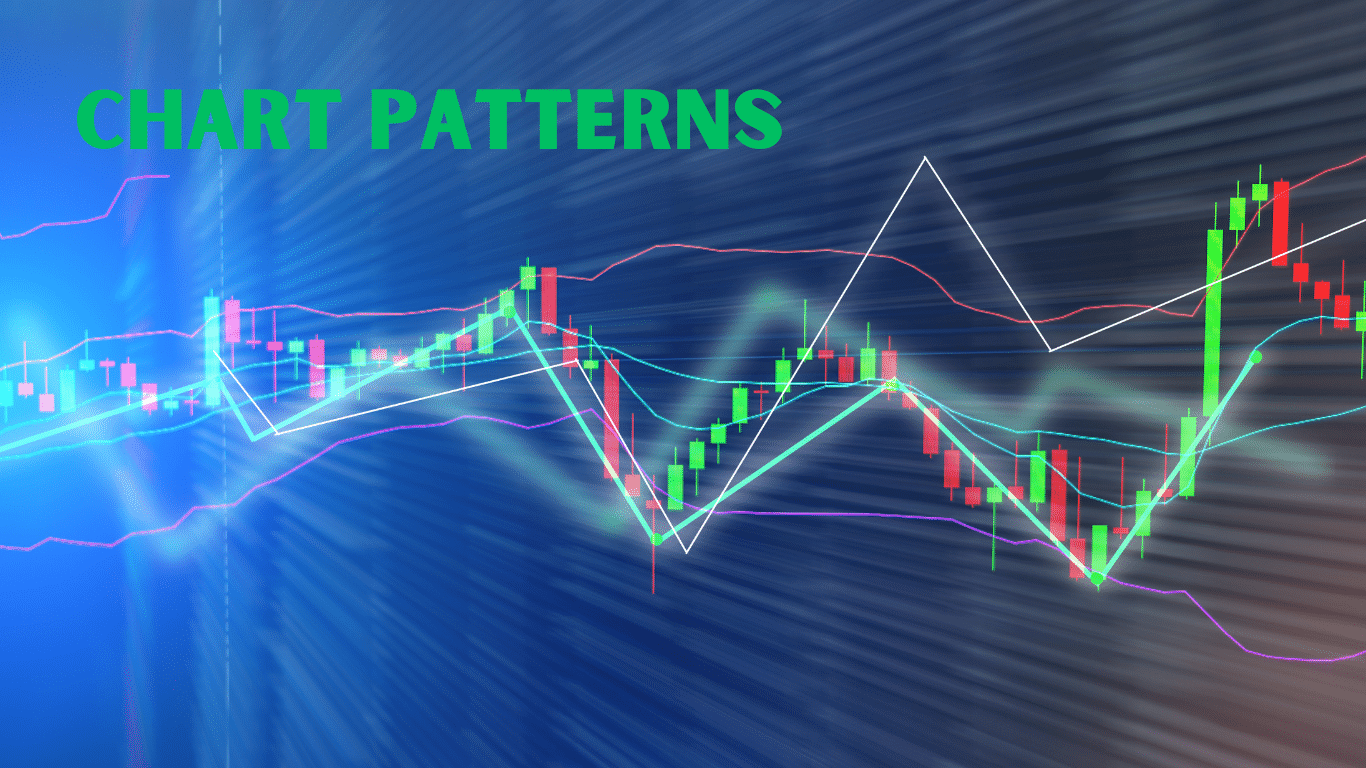Welcome to the dynamic world of trading, where fortunes can change instantly; understanding the significance of chart patterns is a crucial skill. Deeply set within the world of technical analysis, these visual formations hold the key to unlocking the market’s well-guarded secrets. By recognising and grasping these vital chart patterns, traders gain insights into market sentiment, predict potential price movements, and unravel the interplay between supply and demand.
Come and be a part of our captivating adventure as we unravel the significance and rich variety of chart patterns, arming traders with the essential instruments to manoeuvre through the dynamic landscape of the financial markets confidently.

Why are Chart Patterns important?
Chart patterns are crucial in trading, offering insights into market sentiment and psychology. Traders can understand and recognise these patterns to make informed decisions based on market behaviour. These important chart patterns also help identify support and resistance levels, trend strength, and potential reversals, enabling traders to enter and exit positions while managing risk strategically.
By aligning strategies with prevailing trends, traders can capitalise on market movements. Incorporating important chart patterns into risk management strategies allows for logical stop-loss placement, protecting positions from adverse market fluctuations. When combined with other indicators, chart patterns confirm trades, increasing the probability of success. Also, studying chart patterns’ historical performance provides valuable insights into their reliability.
In summary, chart patterns play a vital role in trading, empowering traders to gauge sentiment, analyse price action, identify trends, manage risk, and confirm trades, ultimately leading to more informed decision-making.
How many types of Chart Patterns are there?
The world of technical analysis is replete with diverse chart patterns, each with its own characteristics and implications. Traders skilfully combine these patterns with an array of technical indicators and tools, enabling them to make astute trading decisions. Gaining a comprehensive understanding of these patterns is imperative, allowing traders to accurately grasp their significance and potential ramifications within the dynamic domain of financial markets.
Here are some commonly recognised important chart patterns:
1. Trend Reversal Patterns: Head and Shoulders patterns, Double Tops and Bottoms, Triple Top/Bottom, Reverse Head and Shoulders patterns, Diamond Top/Bottom.
2. Continuation Patterns: Flags and Pennants, Symmetrical Triangle, Ascending Triangle, Descending Triangle, Wedge Patterns.
3. Consolidation Patterns: Rectangle Patterns, Price Channels, Broadening Tops and Bottoms, and Triangles pattern (Symmetrical, Ascending, Descending).
4. Candlestick Patterns: Doji, Hammer, Engulfing Patterns, Morning and Evening Star, Harami.
5. Reversal Patterns: Shooting Star, Hanging Man, Tweezer Tops and Bottoms, Piercing Pattern, Dark Cloud Cover.

What are the common chart patterns every trader should know?
Here are five examples of important chart patterns commonly used in technical analysis. These patterns serve as valuable tools for traders and investors to identify optimal entry and exit points and assess a security’s overall trend.
Ascending Triangle Descending Symmetrical patterns:
Another bullish continuation pattern with a horizontal resistance line and a rising trendline. It suggests that buyers are gaining strength, and a breakout above the resistance line may lead to an uptrend continuation. In technical analysis, the Descending Triangle is recognised as a bearish continuation pattern, marked by a horizontal support line and a trendline that slopes downward, indicating the likelihood of the downtrend persists. It indicates that sellers are gaining control, and a breakdown below the support line may lead to a downtrend continuation.
Traders look for these patterns as they provide precise breakout levels. Entry points are typically taken when the price breaks above an Ascending Triangle’s upper trendline or below a Descending Triangle’s lower trendline. Stop-loss orders are placed on the opposite side of the triangle.
Double Bottom and Double Top patterns:
Those patterns play a significant role. The Double Bottom pattern presents an opportunity for traders to buy, while the Double Top pattern suggests a chance to sell. These patterns provide traders with clear entry and exit points, ensuring well-defined risk management. However, confirming the pattern’s validity is crucial to avoid falling for false breakouts. Traders should exercise patience, waiting for price confirmation and monitoring breakouts above the neckline for Double Bottoms or below the neckline for Double Tops. Entering trades near the breakout point is advisable, accompanied by appropriate stop-loss orders. By combining these patterns with other indicators, traders can make more accurate trading decisions.
The Head and shoulders patterns:
This bearish reversal pattern consists of a higher peak (head) between two smaller peaks (shoulders). It indicates a shift from an uptrend to a downtrend. This pattern offers clear entry and exit points, which traders widely recognise. However, variations in symmetry and false breakouts can occur. To use the Head and Shoulders patterns, traders typically enter a short position after the price breaks below the neckline. Stop-loss orders are placed above the neckline to manage risk. Combining this pattern with other indicators can improve trading accuracy.
Bullish and Bearish Flags:
Are temporary consolidation patterns within strong trends. Bullish flags slope downward, while bearish flags slope upward. Traders can anticipate trend continuation and find favourable entry points. Confirmation from additional indicators is essential to avoid false breakouts and consider varying pattern durations. For bullish flags, traders enter long positions above the upper trendline, and for bearish flags, they enter short positions below the lower trendline. Stop-loss orders are typically positioned on the opposite side of the flag. Combining flag patterns with other analysis techniques and risk management enhances trading success.

The Symmetrical Triangles pattern:
This pattern represents a consolidation phase with converging trendlines, signaling market indecision before a potential breakout. It provides a visual representation of tightening price ranges, indicating an imminent breakout. Traders can apply this pattern to different timeframes and use it in both bullish and bearish markets. However, caution should be exercised to avoid false breakout signals, and confirmation from other indicators is essential for validation.
Traders can enter long positions above the upper trendline or short positions below the lower trendline, with stop-loss orders placed near the opposite side of the triangle to manage risk. By combining the Symmetrical Triangles pattern with other analytical tools and confirmation techniques, traders can enhance their decision-making process and improve the chances of successful trades.
Which Chart Patterns are most successful?
The success of chart patterns in trading can vary depending on market conditions, timeframe, and other factors. It’s important to note that no chart pattern guarantees 100% accuracy in predicting market movements. However, some important chart patterns have historically shown a higher probability of success. Here are 5 basic chart patterns that are often considered to be relatively successful:
The Inverse Head and Shoulders patterns – 89%
Also known as the Head and Shoulders Bottom, is a bullish reversal pattern that signifies a shift from a downtrend to an uptrend. It consists of a lower trough (head) between two higher troughs (shoulders), forming an upside-down “head and shoulders” shape. The pattern suggests diminishing selling pressure and increasing buying pressure. Traders wait for a breakout above the neckline, which acts as a resistance level, to confirm the pattern. This breakout often triggers a bullish move with the potential for significant price appreciation. Stop-loss orders are generally placed below the neckline to manage risk. Volume analysis during the pattern formation and confirmation add further credibility.
The Double Bottom pattern – 88%
Two consecutive troughs and a peak characterise a bullish reversal formation. It suggests a transition from a downtrend to an uptrend, offering traders a buying opportunity. The neckline break is a crucial confirmation point for the pattern, as it validates the bullish move and indicates significant price potential.
Traders commonly set stop-loss orders to manage risk below the pattern’s lowest point. Analysing trading volume during the breakout adds credibility to the pattern. Identifying the Double Bottom pattern allows traders to spot entry points and capture the beginning of an uptrend. However, it’s important to incorporate additional tools and risk management strategies for informed decision-making.

The Triple Bottom pattern – 87%
This pattern signifies a bullish reversal formation characterised by three consecutive troughs and two intervening peaks. It indicates a potential shift from a downtrend to an uptrend, presenting a buying opportunity. Traders confirm the pattern by waiting for a breakout above the neckline, often triggering a bullish move with significant price appreciation. Stop-loss orders are commonly placed below the pattern’s lowest point for risk management. The analysing of trading volume during the breakout can provide additional confirmation. Recognising the Triple Bottom pattern allows traders to identify entry points and capture the beginning of an uptrend.
The Descending Triangles pattern – 87%
This Is a bearish continuation pattern characterised by a horizontal support line connecting lower highs and a downward-sloping resistance line connecting lower lows. It suggests a period of consolidation and signals a potential continuation of the existing downtrend. Traders interpret this pattern as an opportunity to enter or maintain short positions.
Confirmation occurs when the price breaks below the support line, triggering a bearish move. Stop-loss orders are usually positioned above the resistance line for risk management. Volume analysis during the breakdown can provide additional confirmation. While the Descending Triangles pattern is reliable, traders should exercise caution, employ risk management, and consider using other indicators for informed decision-making.
The Rectangle Top – 85%
This pattern forms when the price moves sideways between parallel support and resistance levels. It emerges after an uptrend, suggesting a potential reversal or temporary consolidation phase. Traders focus on breakouts from this pattern, with a bullish breakout confirming the continuation of the previous uptrend and a bearish breakout indicating a shift to a downtrend.
By taking long positions on bullish breakouts and short positions on bearish breakouts, traders aim to capitalise on potential price movements. However, it’s essential to exercise caution, as breakouts may only sometimes be successful. Incorporating other confirmation indicators can enhance the reliability of the breakout signals.

How can important chart patterns be used to pinpoint potential trend reversals or continuation patterns?
- The head and shoulders patterns is a reliable reversal pattern that indicates a possible trend reversal from bullish to bearish. When this pattern is formed, traders look for a break below the neckline to confirm the reversal. Once the neckline is broken, the price will continue to move lower, providing a potential selling opportunity.
- Double tops and bottoms pattern: Double tops and bottoms are also reversal patterns that indicate a potential trend reversal. When a double-top pattern is formed, traders look for a break below the low point between the two peaks to confirm the reversal. Conversely, when creating a double bottom pattern, traders look for a break above the high point between the two dips to confirm the reversal. Once approved, traders can look to enter trades toward the new trend.
- Triangles pattern: Triangles are continuation patterns that indicate a potential trend continuation. When forming a triangles pattern, traders look for a break above or below the pattern to confirm the continuation. If the price breaks above the pattern, it is expected to continue moving higher, providing a potential buying opportunity. Conversely, if the price breaks below the pattern, it is expected to continue moving lower, providing a possible selling opportunity.
In general, important chart patterns can be used to identify potential trend reversals or continuation patterns by looking for specific ways formed by an asset’s price movement. Traders should always look for confirmation of these patterns before entering trades. They should use other forms of analysis, such as technical indicators or fundamental analysis, to support their trading decisions.
Conclusion
Traders can use these important chart patterns to inform their trading strategies by looking for confirmation of the pattern before entering a trade. For example, if a trader identifies inverse head and shoulders patterns, they may wait for the price to break above the neckline before entering an extended position. Alternatively, if a trader identifies a double top pattern, they may wait for the price to break below the low point between the two highs before entering a short position. It is important to note that chart patterns should be used in conjunction with other forms of analysis, such as technical indicators or fundamental analysis, to support trading decisions.
Achieving 2023 Market Profits: New Forex and Crypto Indicators
MACD Indicator – The One Ultimate Guide to Interpretation.

